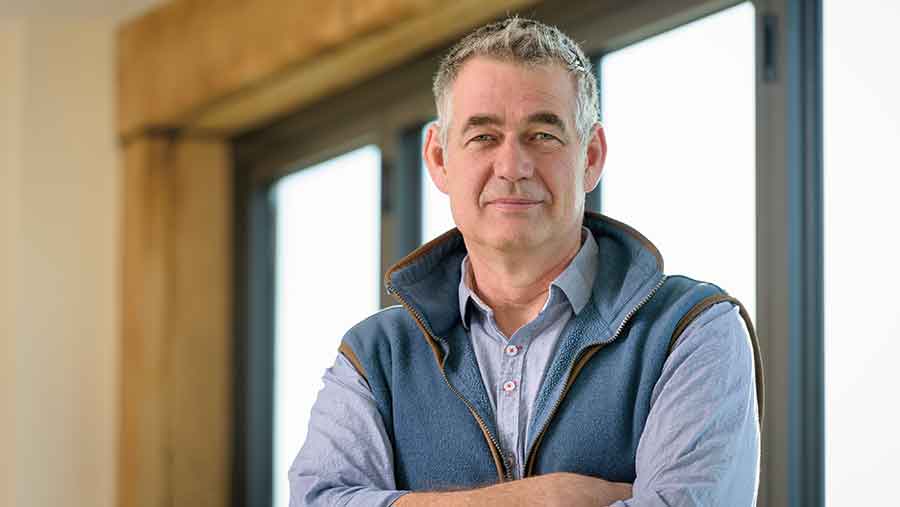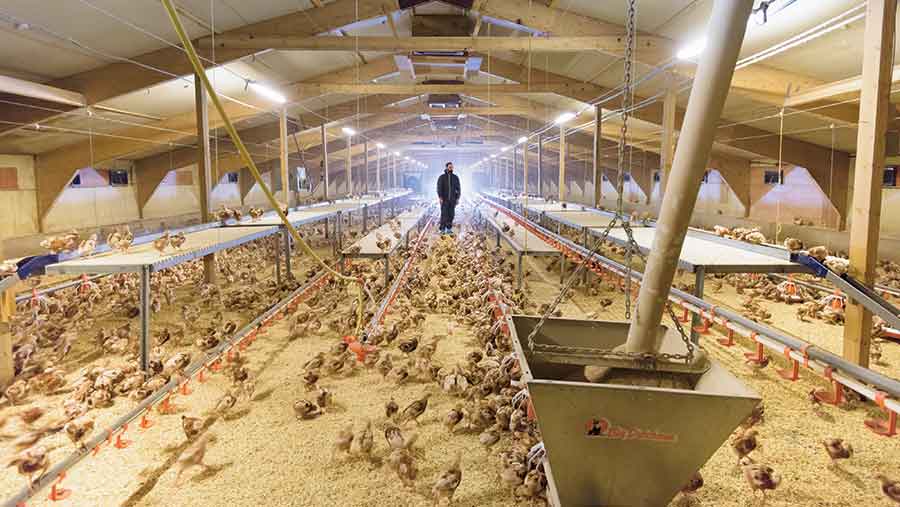Poultry Profile: Wot-A-Pullet MD Matthew Green

© Monty Rakusen
It was frustration at the quality of pullets that led free-range egg producers Matthew Green and Jim Bloom to complement their Wot-An-Egg operation with pullet rearing.
They started out as egg farmers just 12 years ago with two sheds housing about 40,000 hens in total. Rather than going it alone, as two friends they worked together from the outset.
“That business grew very quickly – possibly too quickly,” explains Mr Green. “We went through a price squeeze and decided to convert one farm to producing eggs for vaccines.”
It was in 2008, says Mr Green that a batch of poor pullets led to the pair deciding to bring rearing in house to provide the business with more control over quality and production.
See also: How LED lighting can improve poultry performance
Mr Bloom had several poultry farms available to use for rearing. There was capacity to produce more than their own laying operation required. A decision was made to fill the farm, to make it as efficient as possible, and sell the surplus.
And so pullet rearing began. In that first year 200,000 pullets were taken from day-old to early lay – this year Wot-A-Pullet expects to rear 3.5 million birds. The expansion has been achieved by taking on more farms, leasing sheds from other farmers and expanding beyond Yorkshire; first into Hereford and, more recently, Scotland.
Marketing
Wot-A-Pullet has also invested heavily in a new brand, website and marketing, all in a move to present a more modern, professional image to the business.
Mr Green explains that the company does not rely on landlord farmers to rear pullets, instead having at least one full-time member of staff on even its smallest sites. “I know that if you’re a farmer and you have chickens to look round, but if there’s combining to do, that may take priority.
In profile: Wot-an-Egg and Wot-a-Pullet’s farming estate
Three laying farms in Yorkshire, three rearing farms in Herts, eight in Yorkshire with another one coming in October 2016, five in Scotland, one in Worcester and one in Wales.
“Having dedicated staff means we are fully responsible for everything – if there’s a problem, then it’s only us to blame.”
He adds that one lesson they learnt early on was the importance of incorporating an after-sales care package into the pullet price.
“Now we understand far better that people do need and value help. There will be a small gang of guys to help tip the pullets, and offer weekly visits if required until birds are in full production.”
On farmers visiting their pullets before delivery, Mr Green says it’s surprising how few do it. He compares it to buying two brand-new Range Rovers without taking a test drive.
“I’m hoping it’s because they trust us,” he suggests. One reassuring factor could be the comprehensive report emailed to farmers each week through the rearing process.”
All of these measures are an attempt to differentiate his business in a highly competitive market – and draw from a service he would want as an egg farmer.
He describes pullet rearing as the “Cinderella” of the egg industry. “I think the bar was set quite low,” he says.
“We spend a lot of money on our own facilities and our landlord’s facilities. Buildings are refurbished to a very high standard, and we have more useable furniture than other pullet houses.”
Multi-tier rearing
Useful furniture brings the conversation round to multi-tier rearing. A surprise comes when discussing the time it is taking the RSPCA to approve two new multi-tier rearing systems, designed by Potters Poultry and Big Dutchman.
The three farms Wot-A-Pullet owns in Hertfordshire have RSPCA-approved multi-tier equipment, provided by Jansen.
“Although it’s about seven years old, they are the only fully-licensed farms in the UK and have stood the test of time well,” says Mr Green.

© Monty Rakusen
Birds in Wot-A-Pullet’s other rearing sites are all offered perching above basic requirements, and drinkers are taken up off the ground between 10 and 12 weeks, depending on condition, to get hens used to multi-tier systems.
“Our sheds all have feeders and drinkers at different levels. We are trying to replicate the laying site, so that birds settle into their sheds and consequently start laying quickly.”
Vaccination
On vaccination, Mr Green says the standard programme he implements takes a “belt and braces” approach, but holds back where possible.
Does he feel birds are challenged too much in rear to prevent health problems in later life these days? “You see birds in other countries that don’t have any vaccination, and they perform much better in rear.”
But scaling back a programme in the UK, where a number of diseases circulate, has risks that would likely outweigh the benefits, suggests Mr Green.
“The repercussions of not vaccinating are potentially so vast that nobody is brave enough to start whittling it down.
“If we removed, say, some IB vaccines, some of the time you may get away with it. But if you’re unlucky and get a challenge it’s a lot worse if you have not vaccinated.
One thing that may help is autogenous vaccines, which tailor protection to a specific strain of, for example, E coli to that which is found on a particular farm.
Growth in sales
Mr Green says the growth of Wot-A-Pullet is down to the pullet quality, combined with the service it offers, but he concedes that huge growth in free range since he became established has expanded the market.
“The volume of egg consumed is rising steadily – that is making our lives a lot easier at the moment.
The worry for Mr Green is that, if the colony sector continues to be undermined at retail, there will be oversupply for a long period. “A lot of these colony producers will hang on – they can be fantastically efficient.”
“A farm with its own mill and packing its own egg would be able to hang on for a very long time.”
So the egg sector is likely in for a rocky time. But what about the future of Wot-A-Pullet?
On the farming side, it is forging ahead with new technology – farm offices now have Wi-Fi as standard to make communication and reporting easier.
Mr Green is looking at the potential for cameras, air monitors and other technology to further improve his data recording and to add extra value to the weekly reports that keep customers updated with their flocks’ progress.
Sites are also evolving to become shower in, already having biosecurity standards more akin to broiler units than a laying shed.
Pullet finance offer
Wot-A-Pullet has recently concluded work with Lloyds bank to offer prospective customers a facility to pay the cost of their pullets over an entire flock.
He says it was a service borne out of experience, and offers farmers – particularly new entrants – credit at a time when they are most stretched. “ The standard build cost for a laying farm is now more than £1m.
“Your first bill after the shed is your pullet bill. It couldn’t come a t a worse time, before any money has come back from eggs. So it’s to help smooth cashflow.
The credit is provided to pay for the pullets direct, and is paid back over the 14 months that the birds are in lay.
Though the package was exclusive to Wot-a-Pullet for a limited period, it is now open to any farmer seeking finance for their pullet bill.
Andrew Naylor, head of agriculture at Lloyds says there is increasing demand for loans tailored to a particular production cost.
“Agriculture is a unique industry in terms of its profit cycles, from short-term in pigs and poultry, to annual with crops, to longer term investment in breeding stock and cattle enterprises.
“Loans like pullet finance, which track individual profit cycles, help alleviate working capital pressure and free up cash that would otherwise be tied up in new livestock. They can also support expansion and strengthen your balance sheet.”
